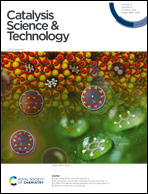Ni and Zn N-confused porphyrin complexes as recyclable catalysts for high efficiency solvent-free CO2 fixation into cyclic carbonates†
Abstract
We designed versatile homogeneous catalysts for the solvent-free fixation of CO2 with epoxides into cyclic carbonates based on the structure of Ni or Zn N-confused tetraphenylporphyrin (NCTPP), in which the outer nitrogen was modified with trimethylammonium bromide. The metal center acted as a Lewis acid whereas the bromide group acted as a nucleophile facilitating the double activation of the epoxide. A turnover number (TON) of up to 70 000 was achieved without a co-catalyst. Meanwhile, in the presence of tetrabutylammonium bromide (TBAB), a co-catalyst, the turnover frequency (TOF) and TON reached up to 370 000 h−1 and 1.3 × 106, respectively, using a moderate CO2 loading of 1.0 MPa. Theoretical calculations revealed that the Zn complex had superior catalytic activity due to its better ability to stabilize the nucleophilic oxygen of the substrate as evidenced by its high global electrophilicity index (GEI) and by reactivity predictors, including the orbital-weighted Fukui indices and dual descriptor. Lastly, the Zn complex was also demonstrated to be re-usable for up to four runs for the formation of glycerol carbonate from the fixation of CO2 with glycidol.



 Please wait while we load your content...
Please wait while we load your content...